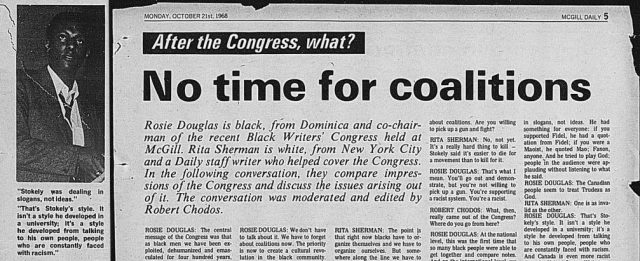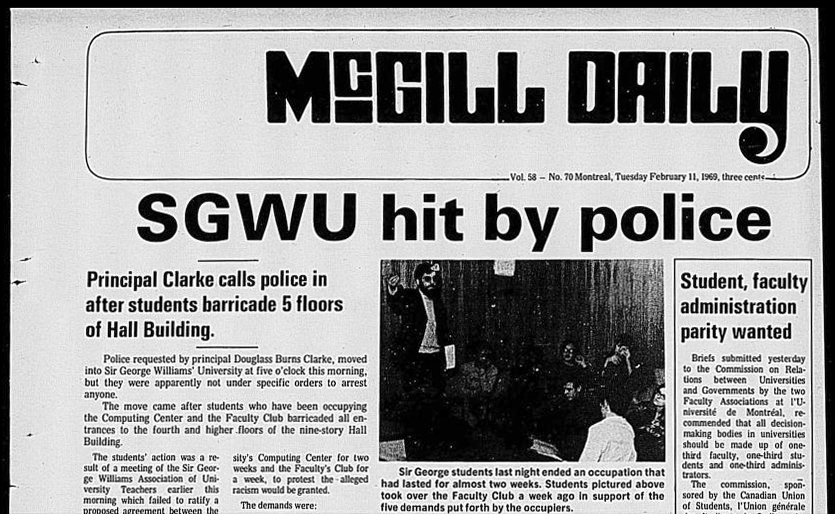Montreal was the hub of sociopolitical change in Quebec during the 1960s Quiet Revolution, a period of intense development in almost all sectors of society. In essence, the revolution redefined Quebec’s identity, solidifying it into what it is today.
This narrative of triumph over struggle – between the church and state, between an anglophone majority and a francophone minority – has been told again and again. But within all the accomplishments and glory, other cultural victories and events developed almost simultaneously in Quebec, yet rarely get recognized in today’s historical retellings. These neglected historical events centred around people of colour (POC) striving for the very thing white francophone culture also sought after: equality.
Why are these stories often left out of historical discourse? I mean, doesn’t this country base itself on ‘multicultural’ and inclusive ideals, and doesn’t it find every chance it gets to show off these ideals? Why has Quebec chosen to leave out one of the most racialized periods of dissent that it’s ever seen?
But within all the accomplishments and glory, other cultural victories and events developed almost simultaneously in Quebec, yet rarely get recognized in today’s historical retellings.
A couple of weeks ago, I had the opportunity to attend a lecture given by David Austin, author of Fear of a Black Nation: Race, Sex and Security in Sixties Montreal. During the lecture, he spoke about Montreal being the hotspot for Black Power movements and the Caribbean left during the sixties. This was a time when POC from all backgrounds and ethnicities stood in solidarity with one another in an attempt to alter a social system that sought to marginalize them in the most insidious ways. That marginalization found success in being subtle yet strong.

Black Power and the civil rights movement up to that point had been primarily associated with the U.S., due to the high visibility and frequency of protests taking place there. Quebec didn’t see itself as having race problems; inequality existed, but supposedly only between francophones and anglophones. The end result was a complete and utter neglect of racial inequality as an issue.
Racial discrimination in Canada was not as codified as it was in the U.S., but to say that it was non-existent is false and dangerously erasing.
Quebec didn’t see itself as having race problems; inequality existed, but supposedly only between francophones and anglophones. The end result was a complete and utter neglect of racial inequality as an issue.
Austin talked about three significant joining points of Black resistance in Montreal: the Caribbean Conference Committee (CCC), the Black Writers Congress, and the 1969 Sir George Williams affair. In his book, Austin describes the CCC’s left political core as “giving birth” to the Black radical tradition in Canada, yet the media hardly recognized any of the anti-racist conferences that were organized by them.
Though the media covered the Black Writers Congress more extensively than before, a similar kind of collective disregard still managed to surface. In October 1968, the Congress was held in Union Ballroom and was dedicated to Martin Luther King Jr. and Malcolm X. Mostly attended by students of colour from both McGill and Sir George Williams University (now Concordia), the conference brought together some of the biggest international names in both the Black Power and Civil Rights movements. Among those in attendance was Trinidadian-born Civil Rights activist Stokely Carmichael who advocated for revolutionary action, while others called for the Quebec government to accept responsibility for its failure to stop racism and racial marginalization. Despite the conference’s success, local and federal institutions continued to dismiss the outcries of marginalized communities.
It was only when things got violent that Quebec and Canada were forced to confront racism head on. What is now called the Sir George Williams affair came to an end on February 11, 1969, after students of colour had occupied the University’s computer room for two weeks in response to mounting pressure on campus from an issue that had begun almost a year prior.
It was only when things got violent that Quebec and Canada were forced to confront racism head on.
In April of 1968, a group of POC students filed a formal complaint to the school’s administration regarding a biology professor who had been continuously failing both Black and Asian students because of their race. In the end, the students felt that their complaints had not been taken seriously by the University and that the only way for their voices to be heard was through direct action. The events that transpired at the sit-in, which included extreme police brutality targeting students of colour and racial slurs from the public left no room for the province to ignore its race issues any longer.
Yet still, even with the backlash from POC community after the Sir George Williams affair, and even with how it mirrored the violent clashes that were taking place in the U.S., this period in Quebec history is rarely talked about. Perhaps the Quiet Revolution cast a long shadow over other histories being made at the same time. Or perhaps, acknowledgment and exposure of POC movements in Quebec at this time is too risky, for it would not only deligitimize the claim that POC in Quebec did not experience discrimination like their American counterparts, but it also cast the province as a villain in a narrative it’s not used to hearing.
Talk Black is a column that seeks to engage in anti-racist culture writing, addressing art, music, events, and more. Jedidah Nabwangu can be reached at talkblack@mcgilldaily.com.
